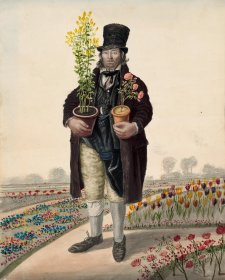William Donkin had multiple claims on local celebrity. To begin with, he was the son of John Donkin who, with his brother James, ran the stage wagon between Scarborough and Hull and, in his youth, Billy was involved in several incidents while driving. One dark night his team of horses bolted when he carried a full load of luggage and nine passengers, and he barely managed to keep on the road, only regaining control after several miles. On another occasion, the wagon was caught in a heavy snowstorm between North Burton and Hunmanby, and stuck fast in a deep snowdrift. Goods and passengers were rescued but it took two days to free the coach.
But, at the age of 22, Billy Donkin went blind, supposedly ‘through inflammation occasioned by cold and night driving’, and he turned to selling hot pies and potatoes through the town, a trade that supported him — and later his aged father as well — for the rest of his life.
For the first four years of his hawking, he whistled his wares through the streets and became so proficient that he was once backed for seven sovereigns in a match against John Allan, another celebrated blind whistler, from the neighbouring market town of Malton. The constant whistling apparently ‘proved injurious to his health’, however, and on medical advice Donkin’s musical output was reduced to ringing a handbell and singing, his favourite numbers being The farmer’s boy and Lashed to the helm. His ear was always good; on one occasion his memory for voices enabled him to identify a thief who had picked a man’s pocket in a pub.
For half a century Donkin cried his ‘Pies all hot!’ around Scarborough, wearing out 16 or 17 tin warming baskets in the process. For 35 of those years he managed the navigation by himself; only when in his 60s did he resort to the conventional blind man’s expedient of a guiding boy.
Coachman, whistler, blind pieman. Donkin had one further career: bridge-builder. In the summer, Scarborough filled with Yorkshire gentry, visiting for the mineral springs, the sea-bathing and the society. During the season, Donkin would station himself next to the stream on the sands under the Cliff Bridge. Laying a wooden plank over the stream, he erected a board with a poster announcing his affliction. In Dempsey’s watercolour we can read at least the beginning of the text: ‘The owner of this bridge (note the clear proprietary interest) having been deprived of his sight for the last 5 years is thereby incapable of obtaining a livelihood by normal labouring work …’.
Donkin would sit by his bridge all day on a wooden chair with one hand on his stick and the other held palm upwards, extracting his tolls from the tourists. In this last role he became one of Scarborough’s living landmarks, and this is how he is depicted both in Dempsey’s portrait and in a contemporary lithograph.
‘Billy’ Donkin died on 31 January 1873, at the age of 74. ‘Invariably modest and unobtrusive, and always lively and happy,’ Donkin was a popular figure in the town, and his funeral was one of the largest in Scarborough’s history.
Collection: Tasmanian Museum and Art Gallery, presented by C. Docker, 1956



Dempsey’s people: a folio of British street portraits 1824–1844 is the first exhibition to showcase the compelling watercolour images of English street people made by the itinerant English painter John Dempsey throughout the first half of the nineteenth century.



Visit us, learn with us, support us or work with us! Here’s a range of information about planning your visit, our history and more!



We depend on your support to keep creating our programs, exhibitions, publications and building the amazing portrait collection!